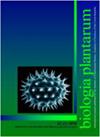立陶宛波动生长条件下的菊花田间性能
IF 0.8
4区 生物学
Q4 PLANT SCIENCES
引用次数: 2
摘要
Festullium品种在立陶宛被广泛使用,因为它们在非生物胁迫下具有持久性,产量高。然而,气候变化挑战了现有的Festullium品种适应新的生长条件并保持产量。在本研究中,我们旨在评估两个Festullium品种在立陶宛波动条件下的田间试验产量稳定性。两个Festullium品种的平均总干物质产量(DMY)在年份之间波动很大,方差分析显示,环境对总DMY和每个切口的DMY有显著影响,但基因型×环境交互作用不显著。在每一年的观测中,使用地块的第一年和第二年的总DMY之间存在很大差异。DMY最高的年份是2015年和2016年。在大多数年份中,第一次切割的干物质产量是总DMY的最大组成部分。在整个研究期间,这些植物在播种后的第一个冬天越冬得很好,导致春季生长良好。地块使用2年的冬季存活分数低于使用1年,与使用2年第一次切割DMY强相关(r=0.81)。在大多数实验年中,使用第1年和第2年的切割后的再生分数非常相似,并且与切割后的DMY总和适度相关(分别为r=0.55和r=0.5)。附加关键词:冠锈病,干物质产量,属间杂交,叶斑病,冬季存活。于2020年9月18日提交,最后一次修订于2020年11月11日,于2020年12月13日接受。缩写:DMY1第一次切割的干物质产量;DMY2第二次切割的干物质产量;DMY3第三次切割的干物质产量;DMY4第四次扦插干物质产量;RG在切割后再生;SG春季生长;WS冬季生存;Y1使用的第一年;Y2使用的第二年。鸣谢:该研究是在立陶宛研究委员会资助的长期研究计划“农业和森林植物性状的遗传测定,现代品种的开发”和“多年生黑麦草在水浸条件下改善生长的全基因组功能分析(GrowGene)”项目的框架内进行的,批准号:。S-MIP-17-24.*通讯作者;电子邮件:grazina.statkeviciute@lammc.lt©作者。这是一篇根据知识共享BY-NC-ND许可证条款分发的开放获取文章本文章由计算机程序翻译,如有差异,请以英文原文为准。
Festulolium field performance under fluctuating growing conditions in Lithuania
Festulolium cultivars are widely utilized in Lithuania because they are persistent under abiotic stresses and are high yielding. However, changing climate challenges the existing Festulolium cultivars to adapt to new growing conditions and still maintain the yield. In this study, we aimed at evaluating the yield stability of two Festulolium cultivars in field trials under fluctuating Lithuanian conditions. The mean total dry matter yield (DMY) of both Festulolium cultivars fluctuated greatly between the years and ANOVA analysis showed a significant effect of environment on total DMY as well as DMY of each cut, but the genotype × environment interaction was not significant. There was a high difference between the total DMY of 1st year and 2nd year of use of plots in each year of observation. The highest DMYs were harvested in the years 2015 and 2016. Dry matter yield of the 1st cut was the largest component of the total DMY for most of the years. The plants overwintered the first winter after sowing very well over the whole study period, resulting in excellent spring growth. The winter survival scores of 2nd year of use of plots were lower than 1st year of use and strongly correlated with the 1st cut DMY of 2nd year of use (r = 0.81). Spring growth of plants at 2nd year of use was poorer, the correlation between winter survival and spring growth of 2nd year of use was 0.62. The scores of regrowth after the cuts of 1st and 2nd years of use were very similar for most of the experimental years and moderately correlated with the sum of DMYs after cuts (r = 0.55 and r = 0.5, respectively). Additional key words: crown rust, dry matter yield, intergeneric hybrids, leaf spot diseases, winter survival. Submitted 18 September 2020, last revision 11 November 2020, accepted 13 November 2020. Abbreviations: DMY1 dry matter yield of the first cut; DMY2 dry matter yield of the second cut; DMY3 dry matter yield of the third cut; DMY4 dry matter yield of the fourth cut; RG regrowth after cuts; SG spring growth; WS winter survival; Y1 first year of use; Y2 second year of use. Acknowledgements: The study was carried out in the frame of the long-term research program “Genetic determination of the traits of agricultural and forest plants, development of modern cultivars” and the “Genome-wide functional analysis of perennial ryegrass for improved growth under water liming conditions (GrowGene)” project funded by the Research Council of Lithuania, Grant No. S-MIP-17-24. * Corresponding author; e-mail: grazina.statkeviciute@lammc.lt © The authors. This is an open access article distributed under the terms of the Creative Commons BY-NC-ND Licence
求助全文
通过发布文献求助,成功后即可免费获取论文全文。
去求助
来源期刊

Biologia Plantarum
生物-植物科学
CiteScore
2.80
自引率
0.00%
发文量
28
审稿时长
3.3 months
期刊介绍:
BIOLOGIA PLANTARUM is an international journal for experimental botany. It publishes original scientific papers and brief communications, reviews on specialized topics, and book reviews in plant physiology, plant biochemistry and biophysics, physiological anatomy, ecophysiology, genetics, molecular biology, cell biology, evolution, and pathophysiology. All papers should contribute substantially to the current level of plant science and combine originality with a potential general interest. The journal focuses on model and crop plants, as well as on under-investigated species.
 求助内容:
求助内容: 应助结果提醒方式:
应助结果提醒方式:


